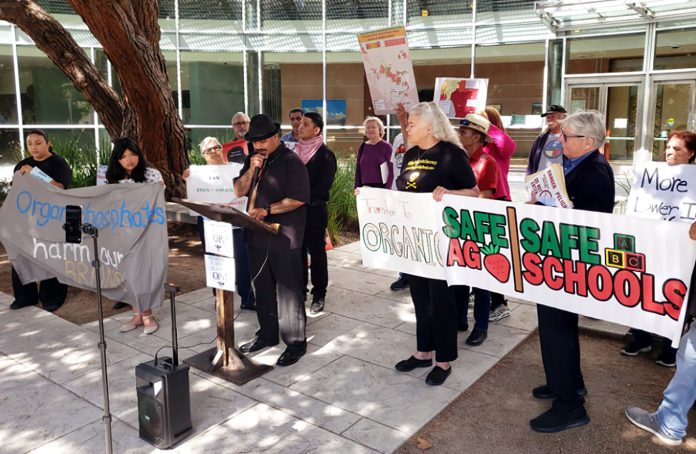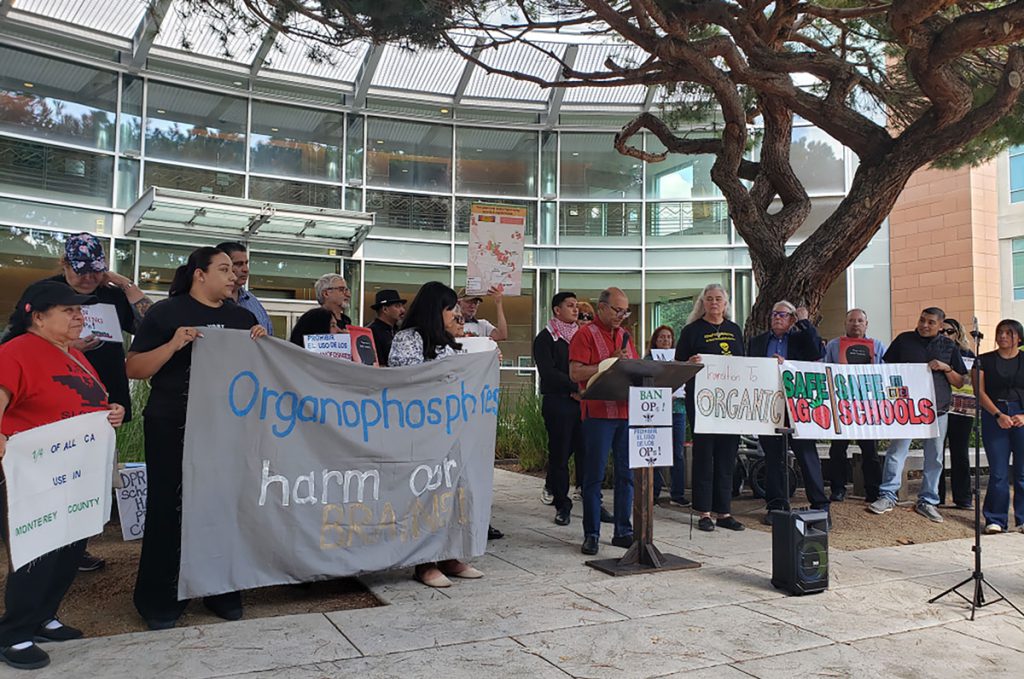
SALINAS VALLEY — Several dozen community members gathered for a news conference at the County Government Center in Salinas last Tuesday to release a new study that found that pregnant women in Monterey County are more likely to be exposed to far higher levels of harmful organophosphate pesticides than anywhere else in California — despite a statewide decline in the use of these chemicals.
The group called for immediate restrictions on organophosphate applications during the Sept. 30 news conference, which was sponsored by Safe Ag Safe Schools, Californians for Pesticide Reform, Future Leaders of Change and the California League of United Latin American Citizens.
The peer-reviewed research, published that same day by public health scientists at the Public Health Institute’s Tracking California and UC Berkeley’s Center for Environmental Research and Children’s Health (CERCH), analyzed pesticide application data and birth records across the state.
Researchers discovered that in 2021, more than half of all pregnant women in Monterey County lived within one kilometer of agricultural fields where organophosphate pesticides were applied during their pregnancies.
Scientists are concerned about this finding because living this distance from pesticide applications has been linked to serious health consequences for developing children, including lower IQ, neurodevelopmental problems and lung damage. A number of these organophosphate studies were conducted by the CERCH team through its CHAMACOS longitudinal birth cohort study of pesticides and other environmental exposures among children in the Salinas Valley.
“Monterey County remains a hotspot for dangerous organophosphate pesticide use that threatens the brain development of children,” said Miriam Rotkin-Ellman, an independent public health researcher and lead author of the study. “To protect maternal and child health — and ensure environmental equity — communities need better protections from organophosphate pesticides. Buffer zones, restricting organophosphate use near homes and phasing out these brain-harming pesticides will better protect future generations.”
Local Use on the Rise
Statewide, use of organophosphate pesticides dropped 54% between 2016 and 2021, largely due to the 2020 ban on chlorpyrifos. But Monterey County saw a 26% increase over that same period. A quarter of all organophosphate pesticide use in California is in Monterey County — 252,510 pounds out of 1,024,626 statewide (2021).
In 2021 alone, more than 2,500 pregnancies in the county occurred within a one-kilometer radius of organophosphate applications. Bensulide — an organophosphate not approved in the European Union (EU) — was the most heavily used in the area, accounting for over 77,000 kilograms. Other commonly applied organophosphate pesticides included acephate, malathion, naled and dimethoate, all of which are banned in the EU.
Racial Disparities
The study also found that pesticide exposure in Monterey County disproportionately affects Latino families. Statewide, 7.5% of all pregnant women lived within a kilometer of organophosphate use. In Monterey County, that number jumped to 57% for Latino residents.
“These are frontline communities who live, work and raise their families near fields where these toxic chemicals are applied,” said Yanely Martinez of Safe Ag Safe Schools (SASS), the Monterey Bay regional affiliate of Californians for Pesticide Reform with branches in Greenfield, Salinas and Watsonville, as well as the regional youth group Future Leaders of Change. “We deserve the same level of protection as people in other parts of California rather than a policy of environmental racism.”

Calls for Stronger Protections
The study identifies a large population, especially in Monterey, that would benefit from protections from organophosphate use in agriculture.
California regulators have the authority to take immediate action, including:
- Establishing stronger buffer zones between pesticide applications and residential areas, schools and daycare centers;
- Phasing out the use of additional organophosphates beyond chlorpyrifos;
- Prioritizing protections for communities facing disproportionate exposure; and
- Expanding environmental monitoring and requiring real-time pesticide use notifications.
Local community leaders in the Monterey Bay region are calling specifically for County Agricultural Commissioners to implement one-mile organophoshate-free buffer zones around residences, schools, hospitals and other sensitive sites, while demanding a complete statewide phaseout from the Department of Pesticide Regulation.
Among the local speakers who expressed concerns and called for changes in organophosphate regulation were Dr. Valerie Bengal, Noemi Chico, Omar Dieguez (on the 30th day of his hunger strike), Kathleen Kilpatrick, Sen. Bill Monning, Jacob Sandoval, Victor Torres and Dr. Antonio Velasco.
Expressing the perspective of many of the speakers, Dieguez said, “If you want to keep a community down, put organophosphates in it. This has got to stop.”
The findings add to growing pressure on the California Department of Pesticide Regulation (DPR), which is currently considering updates to its pesticide rules but has yet to commit to comprehensive protections for residential areas near fields.
“If we’re serious about environmental justice and public health, especially for the next generation, we have to close this gap in protections,” said Jacob Sandoval, State Director of the California League of United Latin American Citizens (LULAC).
The study in BMC Public Health, “Temporal Trends of Agricultural Organophosphate Pesticide Use in California and Proximity to Pregnant People in 2021,” examined over 390,000 California births, combining geocoded home addresses with pesticide use reports from the Department of Pesticide Regulation. It focused on trends between 2016 and 2021, capturing the impact of the chlorpyrifos ban and ongoing disparities in pesticide exposure.
View the study at tinyurl.com/BMCagstudy.









